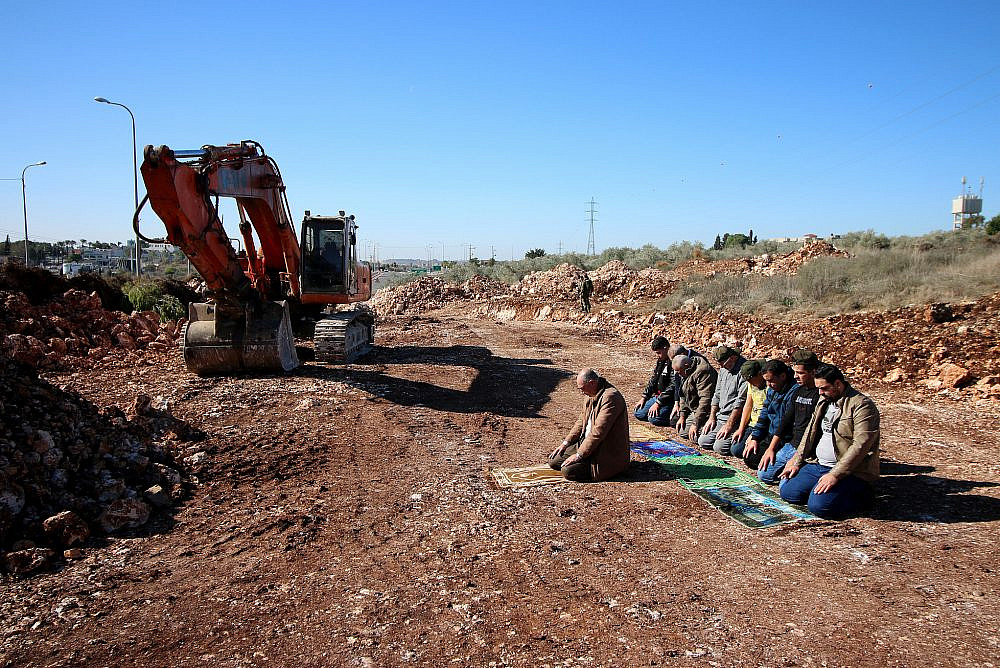Early in the morning on Dec. 3, Ahmad Qaddoura received a call from his neighbor notifying him that bulldozers, likely Israeli, were working on his land in the West Bank village of Kafr Laqef, near Nablus in the northern West Bank.
Qaddoura, 61, immediately left his bakery shop in Qalqilya and drove to his land to stop the construction work, informing the bulldozer operator that the land was his private property.
The operator, a Palestinian who was working under Israeli supervision, had already dug up much of the land when he decided to stop the bulldozer. A few minutes later, the construction site filled up with Israeli security forces, who had arrived at the request of the mayor of Karnei Shomron, a neighboring settlement.
An Israeli engineer informed Qaddoura that an Israeli factory was going to be built on his land, at the initiative of the Karnei Shomron council and approved by the Beit El settlement.
Accompanied by his lawyer, Qaddoura went straight to the District Coordination Office (DCO) in Qalqilya — where Israeli and Palestinian security forces coordinate their activity — in order to prove his ownership of the land.
He presented an Israeli officer in the land department with an Israeli-issued document confirming his name as one of the inheritors of the land, but was told that the land in fact belonged to the state. The officer told Qaddoura to “save my time by taking the documents away and going back home,” he recounted.
As a temporary solution, Qaddoura decided to call the Palestinian Authority and report the Palestinian operator who was working for the Israelis. As a result, the driver left the area after receiving a call from the PA.
Another Palestinian bulldozer operator was brought to Qaddoura’s land early on Dec. 20, when residents of Kafr Laqef were planning to protest at the site. The second operator also received a call from the Palestinian Authority and was forced to remove the bulldozer from the premises after a few days.
At the time of publishing, no bulldozers have returned to the land, which has been severely damaged by the digging.
Qaddoura says that the land belongs to three people, including him and his father. Almost half the land was expropriated a decade ago for Israeli military facilities, including a watchtower — “a decision that you can never legally oppose,” Qaddoura says.
The remaining half of the land has been subject to a decades-long legal dispute between its owners and the state, after being declared state land by an Israeli court in 1986. The land had, however, been left untouched before the bulldozers arrived at the start of December.

Qaddoura’s lawyer, We’am Shebita, has been following the case for some time. He confirms that the state took over the land because it had lain abandoned for over three years. Israeli military law allows the state to requisition land that remains unused for such a period — a law the government exploits in order to confiscate Palestinian land. Shebita says that Israeli authorities had previously photographed the area as proof that it had been abandoned, and believes that the family has no hope of regaining their land.
+972 Magazine reviewed an old military letter addressed to residents of Kafr Laqef, dated June 23, 1986, informing them that the state had taken over the land and giving them a 45-day window in which to oppose the decision.
One of the land’s inheritors, Yahiha Assaf, 50, showed +972 Magazine an undated document his father had filed in an attempt to prove ownership, to which he had attached a Jordanian document confirming his possession of the land. The document had a number of boxes to be filled out describing how the land was used and the period of usage, which had been left empty.
Assaf told +972 Magazine that these parts of the document had been left incomplete because the villagers had not been able to use their land due to the settlements that were built in the wake of the occupation.
“This land was full of wheat before 1967,” he said. But after the occupation commenced, “it was not possible for my family to enter the land due to its closeness to the adjacent settlement,” he adds.
Assaf mentions that his father was attacked by settlers while trying to plow the land, and his plow was confiscated. He adds that his father was the only one of the land’s owners who stayed in the West Bank after 1967; the others left for Jordan in order to escape the military confrontations in the area.
“The land was certainly abandoned,” Qaddoura says. “But why did that happen? This question cannot be ignored.”
Qaddoura notes that he was not counted as part of the census undertaken by Israel in the immediate aftermath of the 1967 Six-Day, and therefore did not receive a West Bank identity card. He managed to travel back to the West Bank from Jordan in 1998 as a visitor and was granted an identity card in 2005. The lack of identity documents can often lead to issues with land ownership.
+972 Magazine visited the Israeli land department at the DCO in Qalqilya to ask about the current owner of the land in Kafr Laqef. When the DCO employee entered the land registration number, Qaddoura’s name popped up and she confirmed that he is the current owner — unless, she said, “something happened” after the document was issued.
However, the Israeli document that Qaddoura has, which confirms him as one of the inheritors of the land, and which he presented to an Israeli official the day the bulldozers showed up, states that it doesn’t prove ownership — rather, it acts as proof of tax registration. So where is the deed of possession?
The Palestinian owners of the land at Kafr Laqef confirmed that they don’t have a such a document. According to Mohammed Assaf, a lawyer at the Palestinian Authority’s Colonization and Wall Resistance Commission which tracks land issues in the West Bank, Qaddoura’s case is not unique: a high percentage of West Bank residents do not possess land ownership deeds, but rather documents issued by the financial department of the Jordanian and Israeli land authorities. Assaf notes that while official ownership deeds would interfere with the state’s ability to expropriate land, tax documents do not.

He further explains that the Ottomans, who regularized land ownership in the region, failed to provide many landowners with deeds of possession. After 1949, Assaf says, the Jordanian government started working on the land registration issue but did not manage to complete the task before Israel’s conquest of the area in 1967.
“If the West Bank occupation had happened a few years later, this would not have been an issue at all,” he declares.
‘This is my land, and I will not leave it’
Yigal Lahav, the head of Karnei Shomron local council, confirmed to +972 Magazine that “bulldozers were marking the land to prepare [for] the building of an industrial zone there.” He said that a Palestinian man had visited him and presented maps “which have nothing to do with reality.”
“I told him: if it’s yours, take it. But it’s empty land, no trees or plantations,” Lahav said.
In an official response, the Coordinator of Government Activities in the Territories (COGAT) told +972 Magazine: “The plot in discussion was proclaimed as state land in 1986, because the lands there are not cultivated lands and not registered in the real estate books.
“We wish to emphasize there the proclamation was done according to the law, including a tour with representatives of the villages in the area and marking the boundaries of the proclamation on the ground,” the statement continues. “At the time of the proclamation, each one is entitled to appeal. There was an appeal following the proclamation, but after it was discussed, it was rejected.”
Although all Israeli settlements in the West Bank are illegal under international law, Palestinians are nonetheless obligated to deal with existing Israeli laws. Legally, the window for contesting the land loss of 1986 has closed.
Yahiha Assaf, an inheritor of the land, expects that the next step will involve an Israeli bulldozer operator being brought to the site, whom the Palestinian Authority can’t stop. “They have been working gradually,” Assaf says. “Last time we entered the land to plant some olive trees and protest but next time they will use force to evacuate us.”
For Ahmad Qaddoura, there is no choice left other than “to confront the Israeli army.”
“This is my land, and I will not leave it if they try to start working on it again.”


